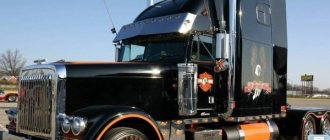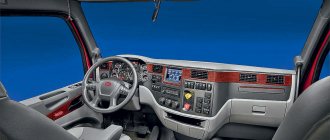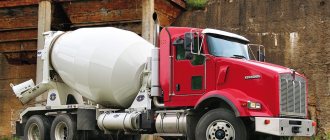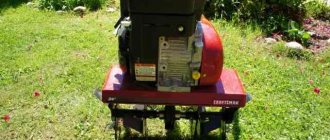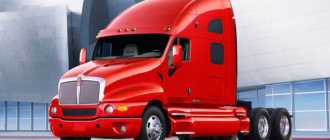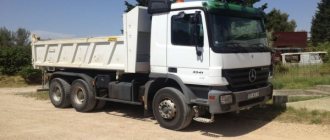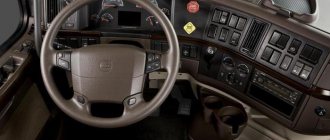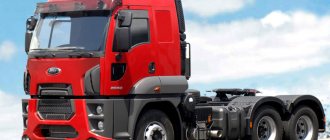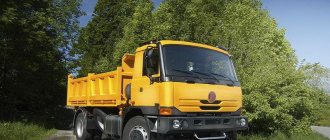Bright and powerful, economical and luxurious - this is how the flagship Peterbilt 387 tractor should be.
The American heavy commercial vehicle market is not rich in brands. But, as a rule, these are brands with a long, difficult history, producing exceptionally high-quality and powerful tractors. The Peterbilt company began its history at the beginning of the 20th century with a chain of coincidences and events that led to the creation of the Peterbilt brand in 1939, on the threshold of World War II. Of the latest tractors assembled in the 21st century, car enthusiasts and professionals are very familiar with the Peterbilt 387 - a model that has become the face and embodiment of the American spirit of Peterbilt, albeit not for a long time.
Peterbilt 387: flagship characteristics and history
The car's official release dates spanned eight years, from 2002 to 2010. Although the model began to be tested and run-in already in 1999. The main idea was to create a streamlined cabin with modern aerodynamic performance. To achieve economy and smoothness and, at the same time, get a powerful and luxurious tractor - this is the task that Peterbilt designers achieved.
The fact that production was limited to such a short period does not speak of the car’s shortcomings, but of following the trends of the times. In the future, the flagship was replaced by the no less successful Peterbilt 587 truck. The new tractor remained faithful to the style of the 387 predecessor, adding traction and refining the cab design. At the same time, the car’s efficiency has increased further.
Peterbilt is one of the few pioneering companies in the field of hybrid vehicles. Among truck tractors, the 386 model was taken as the basis for the new hybrid. The operating principle of such a tractor is to save energy from braking, which accumulates in Li-ion batteries and is transferred as power to an electric motor working in tandem with a diesel engine. In addition to this “heavy” machine, the company also presented a compact version for urban utilities - the Peterbilt Model 320 with revolutionary technology that allows saving up to 60% of fuel. Such savings are possible due to the abandonment of the battery in favor of diesel operating technology with the original hydraulic motor system developed by Eaton.
The official presentation of the Peterbilt 387 took place in 2002. Despite the extensive experience in producing cabover tractors, this vehicle is made according to the classic canons of an American truck with a protruding hood. Is that the style of the car is more reminiscent of the American Volvo VNL than the classic Peterbilt. But this is only an appearance.
Peterbilt 387: interior and cabin
Peterbilt 387, one of the first tractors of its kind, achieved an excellent result - a significant reduction in fuel consumption due to the parameters and shape of the cabin.
The main thing in this is not the power hidden under the hood, but the most visible part - the cabin. The typical Peterbilt cab is square, with a powerful hood protruding forward. Here the cabin is smoothed, has a wedge-shaped and streamlined shape. Reduced aerodynamic drag allows you to save up to 13% fuel.
More on the topic: Special marks on cargo
This was possible to achieve due to the elongated and slightly expanded cabin. The cabin was based on the characteristics of the 377 series, which took the first steps towards taking aerodynamics into account in production. Compared to the cabin of the 377, the width has increased by 76 cm, the shape of the wings and headlights has changed. The softening of the features begins from the radiator grille and ends with a smooth transition into the sleeping compartment.
Peterbilt interior
The craving for impressive space inside the cabin is a typical feature of an American-style tractor. A truck driver from the States is a lover of riding with carefully thought-out comfort. Hence the large salon: you can walk around it at full height, and the sleeping place is designed for the most immodest dimensions. At the same time, the capacity of the cabinet allows you to build in a TV, refrigerator, microwave oven and much more.
Adequate rest, as well as meals during rest, is the key to good work. The dashboard, in the spirit of Peterbilt trucks, has not undergone any significant changes. Chrome-plated round gauges on a noble wooden panel are abundantly reminiscent of aircraft technology. The windshield is monolithic, there are two viewing windows on the sides. For better lighting, windows are also provided in the sleeping compartment.
Peterblilt 387: technical specifications
A vehicle like the Peterbilt 387 tractor is designed to be converted into a luxury motorhome. However, the comfort of home is also felt in the regular tractor of the basic version.
The truck's wheel arrangement is optimal - 6x4. Chassis characteristics: front suspension on parabolic springs, with fastening through threaded pins. At the rear there are air springs and beam springs, also on a threaded mount. There is no balancer between the bridges; they are suspended independently.
The Peterbilt 387 design has important innovations that can significantly simplify and save on tractor repairs. The first concerns the radiator cooling systems and the intercooling radiators themselves: by changing the location (next to each other, and not one after another), the radiator airflow is significantly increased and the overall heating temperature is reduced. The electrical system servicing the tractor is divided into four parts (chassis, rest compartment, cabin and semi-trailer) and isolated, which makes it possible to more accurately identify a malfunction and carry out repairs more quickly.
Caterpillar was selected as the engine manufacturer. Two engines C13 and C15, with a power of up to 550 horsepower, were enough to implement all transport tasks. However, towards the end of production, the tractors acquired a new product. Thus, the Cummins ISX appeared in the range of engines, which quickly spread among American cars. With a maximum thrust of 565 hp. This engine has very up-to-date technical data.
The engine has an EGR - exhaust recirculation system. Thanks to it, the motor has an EPA certificate indicating respect for the environment. New items include an overhead cam system developed by Cummins engineers and electronic engine control - the Fleetguard system. The system monitors the engine condition and records operating parameters.
More on the topic: Delivery and transportation of goods: details and nuances
The inspection interval is every 50-odd thousand kilometers. An advanced Centinel cleaning system is also optionally installed. Its presence allows you to delay oil changes until the mileage mark of half a million miles. Such an engine has a greater safety margin and, as a rule, is cost-effective. The car does not have the usual speed limit of 90 km/h.
The maximum speed can reach 120 km/h. The Fuller transmission is available in two gearboxes: an 18-speed manual and an automatic with up to 13 steps to choose from. Average fuel consumption is 40 liters per 100 km minimum. Considering that the maximum weight of the road train is 56 tons, these figures do not seem so large. The capacity of two fuel tanks allows you to make a long journey without stopping or refueling. Their volume reaches 500 liters each, depending on the configuration.
Cabin features
The designers made every effort to make the driver feel comfortable on long trips. The three-seater cabin was made of aluminum, which made it possible to significantly reduce its weight. The cabin was produced in two internal versions. For Peterbilt 379 trucks intended for local use, there was no bed. And for models that were supposed to be used for long-distance transportation, the cabin was equipped with a special Unibilt Cab Sleeper System. This made it possible to add a sleeping place to the work compartment. The rest compartment could have a length of 914, 1219 or 1600 millimeters. The berth is equipped with a soft mattress, which allowed one driver to have a good rest while driving, while his partner was in charge.
The cabin was equipped with comfortable seats with folding armrests, high backrests and air suspension. Of course, it was possible to adjust the seats in height and backrest angle. The well-designed suspension absorbs the vibrations that occur when driving on uneven roads. The salon was equipped with all the necessary “conveniences”. In hot weather, you could turn on the standard air conditioning and enjoy pleasant coolness, despite the scorching sun outside. And during the cold periods of the year, an autonomous heater was used, which created a comfortable temperature in any weather.
There is a radio in the cabin, which allows the driver not to get bored on the road. It receives all available stations in a specific region, and also plays music from removable media. The steering wheel is equipped with a hydraulic booster, so driving the car is very easy. In general, despite the impressive dimensions of the vehicle, it listens well to the driver and quickly performs the desired maneuvers.
Reviews Peterbilt 387
Igor, Moscow region, Peterbilt 387 tractor, mileage 950 thousand kilometers.
I have always dreamed of such a car and have been nurturing the idea of buying it for a long time - I was looking closely at what could be bought in Moscow and the Moscow region. After much deliberation, I took this tractor, although it was in poor cosmetic condition. True, the filling is okay, but I had to invest in it. I completely changed the lighting in the cabin, along with the headlights, and it cost about 7 thousand rubles. The cabin had to be repaired - it was literally held together by snot. The wheels had to be repainted. Everything is fine under the hood. The engine went to Cummins 15-liter, but without recirculation. About the qualities of the car: huge, luxurious. Just look at a full-fledged kitchen with a table and a refrigerator; you can do morning exercises in the sleeping compartment. But if you left things in the front passenger seat, you won’t be able to reach them during the trip.
The Peterbilt 387 also has a significant drawback - a dead zone on the right. A blind spot forms at the right door, and it is quite difficult to solve this issue. There is no way to adjust the mirror and it looks strange. Almost the only option is to install a spherical mirror, like at the checkout counters in a store. It solves the problem, although not 100%. According to those parameters, the car is reliable, although graceful maneuvers are difficult for it due to its dimensions. Original spare parts are wildly expensive, but the car is tolerant of some things. For example, threaded pins can be installed from other brands, as well as lighting lamps. I'm happy with the purchase, because this is what I dreamed of. In principle, there is not much difference between “Petka” and “Fedka” (Fredliner), mainly on the outside. It's just a matter of taste, or maybe habit. The main thing is to love the car and it will repay you with a long service.
All technical equipment is at the highest level
The controls are conveniently located and well equipped. Huge rear-view mirrors provide an ideal view of the roadway behind the car. The windshield gives a good view of the road in front of the car's hood. It is additionally equipped with a visor that protects the driver from glare from the sun's rays. The main tractor is equipped with powerful optical devices that have high lighting characteristics that meet all international standards.
Peterbilt 379 tractors were equipped with a high-precision braking system, which made it possible to quickly stop a multi-ton vehicle in the event of any extreme situations on the road. There were also additional electronic safety systems that helped the driver cope with emergency situations. The dashboard made it possible to always have all the main indicators before your eyes.
Peterbilt 379 trucks were built on a redesigned Kenworth W900L chassis. The main feature of the new base was the narrowed track of the front wheels, which made it possible to reduce the turning radius of the car and make it more maneuverable. The tractor received telescopic hydraulic shock absorbers and anti-roll bars. These devices allow you to easily overcome minor road irregularities without the risk of turning the car on its side.
